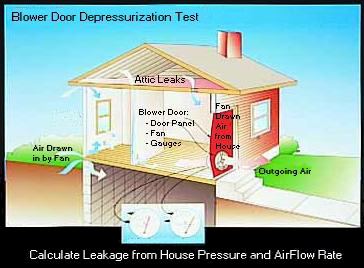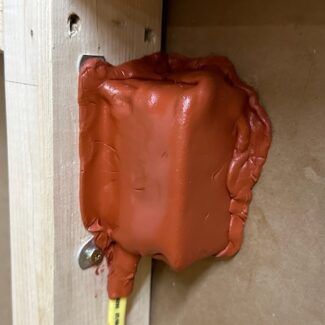There are several ways to find duct leakage:
- Using a duct leakage tester and blower door together (the most common method)
- Using a flow hood
- Using a blower door and pressure pan (for diagnostic purposes only)
- Using a blower door only (not recommended)
The basic idea behind using a duct leakage tester to test for duct leakage is:
- Use a calibrated fan to pressurize the duct system.
- Measure the airflow through the fan with the duct system at pressure.
Just as when you’re testing for airtightness, each cubic foot of air that leaks out (of the duct system in this case) must be made up by a cubic foot of air blown in by the fan. So, once you’ve measured the amount of air moving through the fan, you’ve quantified the duct leakage at the test pressure.

For duct leakage testing, the standard pressure used is 25 Pascals, which is close to the operating pressure of a typical duct system. This means that when we measure, say, 120 cubic feet per minute of duct leakage at 25 Pascals (written 120 cfm25), that number is a pretty good estimate of how much air leaks out of the duct system while it’s operating.
Going a little deeper now, there are two kinds of duct leaks – let’s call them benign and malignant. The malignant leaks are the ones we really care about. They’re the ones that send conditioned air into unconditioned spaces or suck unconditioned air into the system. Benign leaks are the ones leaking inside the conditioned space; they don’t exact an energy penalty.
Two kinds of duct leakage, of course, require two types of tests. The malignant leaks occur in ducts that are outside of the conditioned space, or outside the building envelope, in building science jargon, so the most important test is called the ‘outside leakage test’ or the ‘leakage outside the envelope test.’ The other test is not, as you might expect, the inside leakage test, but rather the total leakage test. Read more about these two tests by clicking the links below.
Soundproofing a Wall – The Basics
You know how the sound from that TV in your den comes right through the wall and you can hear…
Allison Bailes provided HERS training to me at a recent HERS Rater training course. He is extremely knowledgeable in building science and provided excellent training. He also is very patient and was very concerned about providing the requisite information for his students to not only pass the HERS training curriculum but to ensure that we as HERS raters would be best prepared to execute this training in the field. I highly recommend Allison for training or other services he may provide in the area of building science.

